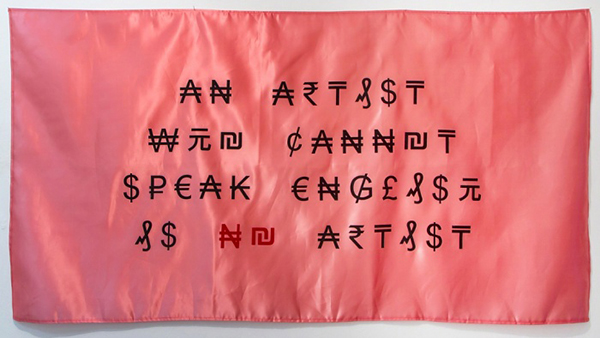The Influencing Machine
Exposition
With Luchezar Boyadjiev, Nina Czegledy, Ole Dammegård, Aleksandra Domanović, Constant Dullaart, Harun Farocki, Jakup Ferri, Andrea Fraser, Adrian Ghenie, Ferenc Gróf, Naomi Hennig, Mi Kafchin, Jon McNaughton, Yerbossyn Meldibekov, Suzanne Meszoly, Mike Z Morrell, Ciprian Mureșan, Lucia Nimcova, Oksana Pasaiko, REP Group, Joanne Richardson, Șerban Savu, Keiko Sei, Sean Snyder, SOSka Group, János Sugár, Andrei Ujică, Anetta Mona Chişa & Lucia Tkáčová, GulnaraKasmalieva & Muratbek Djumaliev
----
Inspired by a True Story: What was the Network of Networks?
Thirty years ago as the Soviet Union collapsed, the Open Society Institute, an unprecedented civil society initiative created by philanthropic activist George Soros, stepped in to facilitate vulnerable transition in most major cities throughout Eastern Europe and Central Asia. This non-governmental organization helped to implement a wide variety of neoliberal educational initiatives in areas such as public health and independent media that accelerated the path towards democracy and free-market thinking—ideals that were often incompatible with the previous system. One of the prolific ways this was done was by ushering in the most avant-garde program of contemporary art in human history in the form of the Soros Centers for Contemporary Art (SCCA), established in twenty major cities across the former bloc.
Arriving with a pedagogical evangelism for Western-style cultural production, the SCCA networks had operating budgets that asymmetrically dwarfed the pre-existing Artist Unions or state budgets for art. A new and superior art world appeared overnight. The centers set up a collaborative network within each major city and across the network as a whole: providing grant money, facilities, know-how, publishing, research databases of local artists for foreign curators and also infrastructure to cultivate off-shooting branches, events, education programs, etc. In places like Chisinau, Moldova the SCCA is credited with introducing the very idea of contemporary art as they would come to know it. The change has often been referred to as a “necessary upgrade” by former SCCA Chisinau director Octavian Esanu, who goes on to say it was “something happening across the newly independent states like what the IMF was doing for these same economies.” The result was in fact radically transformative.
In addition to pioneering the internet in the form of hands-on education and first-time access, the OSI also, in certain cases, laid the fibre optic cables and created the satellite networks for the fastest public internets in the world. An entire ecology of media resources from OSI-funded TV stations, radio, newspapers and magazines were at the SCCA’s disposal to communicate the message, experiment with the medium, and have an unprecedented and hopefully irreversible reach of communication in places where the democratic voice of the people had historically been easily suppressed. Their presence reinvented hierarchies of quality and schools of thought through the institutionalization of culture. They invented the notion of the “cultural manager” and influenced the rise in curatorial practice as a watchdog in the field.
Depending on the location, the SCCA program had a 5-10 year shelf-life. The latter years were referred to as the “Sunset Years” where as quickly and suddenly as they had come, they would exit. The network would downsize the budget annually with the notion that the centers would stand on their own through the knowledge and infrastructure they had acquired. And by then, a new generation of philanthropist would hopefully step in to take responsibility. The SCCA Zagreb or the SCCA Ljubljana, for example, successfully transitioned into independent operations and prospered to become the leading institutions of their art worlds. For others that was not the case. They shut down in slow motion, a shadow of their bombastic beginning. Art worlds would remain problematically divided in their wake. And now the SCCA’s histories are fast disappearing just like those they had stepped in to save.
What is The Influencing Machine?
The exhibition at Galeria Nicodim is as much about influence as it is an experiment in influencing. It is inspired by the SCCA network and reflects on the legacy anthropologically, turning the SCCA’s method in on itself. It employs a recursive format where form, function, meaning and interpretation are in a closed loop, a self-oiling machine, a meta-SCCA. It analyzes the SCCA’s practice of institutionalizing cultural networks and directionalizing cultural production—an invention of new patterns, practices and traditions that would fast become sacred. The exhibition includes iconic works, important themes, case studies, archival material and newly commissioned projects from international artists born out of this period or reflecting on it. The exhibition has five sections that lead the viewer through a spectrum of history, data, and aesthetics.






